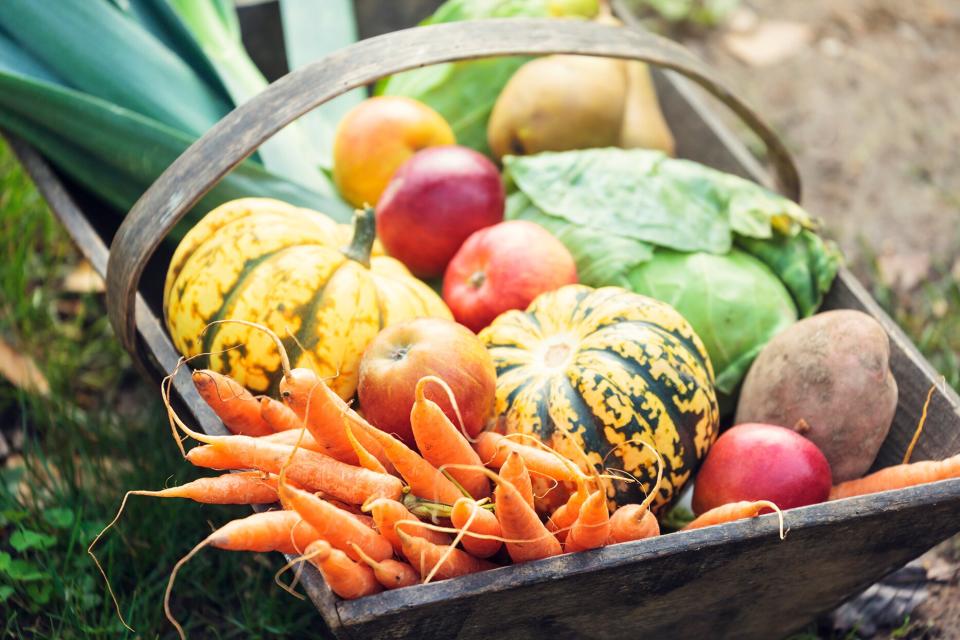How to Properly Harvest Vegetables
The only thing better than growing vegetables in your home garden is harvesting them. However, depending on the species, knowing when and how to properly pluck certain vegetables can be tricky. "Most folks know tomatoes are fruits, but so are cucumbers, peppers, and squash," explains Daniel Cunningham, a horticulturist at Texas A&M AgriLife. These 'veggies' have different harvesting requirements than our true vegetables like carrots, potatoes, or radishes or leafy greens like spinach, kale, or lettuces."
So, how can one determine when a vegetable is ready to be harvested? "Generally speaking, the size, color, and the feel of the vegetable when you give it a gentle squeeze are reliable indicators that it is ready to enjoy," Cunningham says. "However, if they are harvested too early or late, you might not be enjoying them at their peak flavor." Unsure if you're picking your vegetables the right way or at the right time? We asked Cunningham for tips about when and how to harvest a handful of popular varieties—and here's what he had to share.
Related: How to Grow and Harvest Asparagus at Home

Getty / Brzozowska
Root Vegetables
Cunningham says that many root vegetables like carrots, beets, and radishes, begin to bulge up slightly above the soil when they are ready to harvest. "It's a good rule of thumb to remember the 'days to harvest and maturity' date that was printed on the seed packet for a general time frame," he says. "Carrots should be ready in 60 to 80 days, while radishes are ready quite a bit sooner at around 20 to 60 days." Since each root vegetable has a different time frame, he suggests testing a few larger specimens when they are nearing maturity by firmly grasping and wiggling the veggie where it rises above the soil. "If they don't move easily, give the plants a bit more water and try again in a few days," he says.
Potatoes
When harvesting potatoes, Cunningham says it's generally best to wait until the top part of the plant begins to wither and die back. "Avoid watering during that time to allow for an easier, quality harvest," he says. "The only caveat that would warrant an earlier harvest is if a hard frost is expected." When it comes time to pick the potatoes, he says it's a good idea to test one plant, using a shovel or spade fork to carefully expose, lift, and sort through the root system. "If the skins of the potatoes are thin, you might choose to wait a few more days to harvest the others."
Leafy Vegetables
According to Cunningham, most leafy greens taste best when they are harvested right when they reach the mature size for that species; varieties typically come in around three- to six-inches long (or as denoted on the seed packet). "Leaf lettuce, spinach, Swiss chard and most other leafy greens can be harvested in one of three ways," he says. "The first method is to use scissors or shears to cut larger single young leaves as they mature for use. You can also choose to harvest the smaller young leaves and keep the larger leaves to help photosynthesize through the season, or you can harvest the top one-third to one-half of each plant, using sharp clean scissors to shear the upper part of the leaf."
Herbs
Depending on the type of herb you're growing, when and how you clip herbs will vary, Cunningham says. "Perennial cold hardy evergreen herbs like rosemary, sage, thyme, and oregano can be harvested as needed by cutting the tips of their branches with pruners or kitchen shears most any time of the year," he says. "Certain annual or biennial herbs like cilantro, dill, and parsley thrive in cooler temperatures and should be planted and harvested during the cooler parts of the year in spring and fall, avoiding summer's scorching heat. Once these plants bolt and set seed, their flavor usually declines."
Tomatoes
While tomatoes are at their most flavorful when allowed to fully ripen on the vine, Cunningham says it's not always practical to wait that long to harvest them. "Birds and insects, extreme temperatures, or even a heavy rainfall event can contribute to losses in yields," he explains. "One trick is to pick tomatoes when they start to show 'pink shoulders,' or just when the very tops of the fruit start to transition from green to red. These almost, but not quite, ripe tomatoes can be after-ripened in a brown paper bag on the kitchen counter, or any spot that isn't too hot or too cold, and be almost as good as if you would have waited to let them ripen on the plant."

